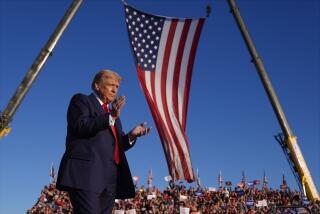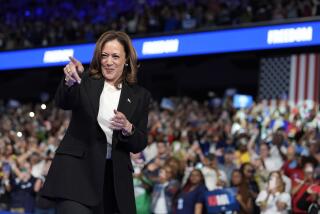Little enthusiasm in Maryland for GOP presidential primary
- Share via
Reporting from Baltimore — Despite high-profile races — including a Republican presidential contest that brought the candidates swinging through the state and a nationally significant House race -- elections officials in Maryland predict that turnout could fall to near-record lows in Tuesday’s primary.
The ho-hum reaction in Maryland is being driven by several factors: lack of a competitive race at the top of the Democratic ticket; a primary date that falls in the middle of spring break for many schools; and the inability of most of the GOP presidential candidates to organize in one of the bluest states in the nation.
The outcome of the state’s primary voting will not be without consequence. Maryland Republicans could reinforce former Massachusetts Gov. Mitt Romney’s front-runner status in the GOP presidential primary — or could surprise pundits and alter the course of the race by backing someone else. Democrats in the 6th Congressional District will choose a candidate to contest a House seat that has been held by Republican Rep. Roscoe G. Bartlett for 20 years.
But none of it seems to be generating much enthusiasm.
“We’ve done everything we can to get the voter turnout,” said Ben Cardin, a Democrat who faces opposition in his bid for a second term in the U.S. Senate. Cardin says he’s been to political events in recent days at which people are unaware that the primary election takes place Tuesday. “It’s been a struggle.”
State election officials report that 76,124 Marylanders took part in early voting, about 2.4 percent of eligible voters. That’s down from the 77,288 who cast ballots before Election Day in the 2010 gubernatorial primary, the first year in which early voting was allowed. If those numbers are an indication of voting overall, the state could see a turnout of less than 25 percent.
“People tend to really focus on the general election,” said former Gov. Robert L. Ehrlich Jr., who heads Romney’s presidential campaign in Maryland — an effort that included a town hall meeting March 21 in Arbutus. “We’re sort of in the fourth quarter with a comfortable lead, so there’s not a lot of people left in the stands.”
A Public Policy Polling survey released Monday supports Ehrlich’s assertion. According to its results, Romney leads Santorum in Maryland 52% to 27%, with 10% for Newt Gingrich and 9% for Ron Paul.
Maryland offers up to 37 delegates to a candidate for the GOP convention this summer. Twenty-four of the state’s delegates are awarded by congressional district, 10 are awarded to the winner of the popular vote and three go to state party officials.
Theresa Marozza, 74, a Severna Park Republican, says she has contributed money to Santorum, voted for Gingrich and thinks just about any of the GOP candidates would be better than President Barack Obama. Marozza, standing outside an early-voting center in Glen Burnie, said booting out the current administration was her main motivation to vote.
“I’d vote for anybody to get you know who out,” Marozza said. “He has taken us down the tubes.”
Longtime Glen Burnie residents John and Barbara Schmid said they appreciated that most of the Republican candidates came to Maryland, a state often overlooked in presidential elections. He voted for Gingrich. She is backing Santorum.
But Barbara Schmid, 49, said she’s all too aware that Maryland is a sure bet to back Obama in November.
“We feel like we need to put our voice out there, put our vote out there,” she said.
Obama does not face a challenge in the Democratic primary. In a state where registered Democratic voters outnumber Republicans by a margin of more than 2-to-1, it is unlikely that the marginally competitive GOP presidential primary will drive a lot of people to the polls. John Willis, Maryland’s secretary of state from 1995 to 2003, compared this primary to 1996, when then-President Bill Clinton was running for a second term.
Turnout that year slipped to 22 percent of registered Democrats and 35 percent of registered Republicans, according to the Maryland State Board of Elections.
“What drives turnout in presidential years is the competitiveness of the race at the top of the ticket,” said Willis, now executive in residence in the School of Public and International Affairs at the University of Baltimore. “You don’t have the competition going on on the Democratic side.”
Timing is another factor causing confusion with some voters. In 2008, Maryland, Virginia and the District of Columbia voted Feb. 12 in what became known colloquially as the Potomac Primary. But last year, the General Assembly changed the date to April 3 after the national parties prohibited most states from holding primaries before early March.
The day lawmakers chose falls during spring break for many school systems in the state, including Baltimore and Montgomery counties. That means that many families will be out of town on vacation.
Turnout “is going to be very light,” predicted Senate PresidentThomas V. Mike Miller.
More to Read
Get the L.A. Times Politics newsletter
Deeply reported insights into legislation, politics and policy from Sacramento, Washington and beyond. In your inbox twice per week.
You may occasionally receive promotional content from the Los Angeles Times.










